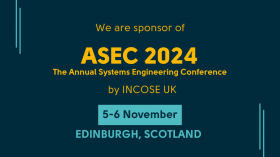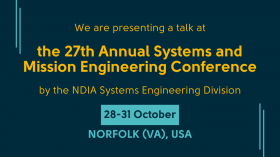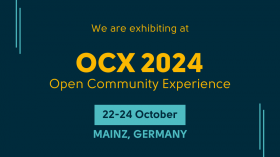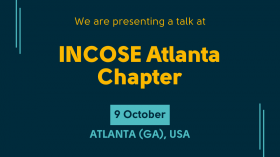 Obeo will exhibit at the Annual Systems Engineering Conference
ASEC 2024 will be taking place on 5-6 November 2024, at the EICC (Edinburgh International Conference Centre), Edinburgh. It gives a platform for presenters and practitioners to provide engaging content as they explore the theme ‘New Beginnings’.
Come to meet us at our booth to talk about Capella and MBSE.
For more information, follow the link....
Obeo will exhibit at the Annual Systems Engineering Conference
ASEC 2024 will be taking place on 5-6 November 2024, at the EICC (Edinburgh International Conference Centre), Edinburgh. It gives a platform for presenters and practitioners to provide engaging content as they explore the theme ‘New Beginnings’.
Come to meet us at our booth to talk about Capella and MBSE.
For more information, follow the link....
News
 Obeo will exhibit at the Annual Systems Engineering Conference
ASEC 2024 will be taking place on 5-6 November 2024, at the EICC (Edinburgh International Conference Centre), Edinburgh. It gives a platform for presenters and practitioners to provide engaging content as they explore the theme ‘New Beginnings’.
Come to meet us at our booth to talk about Capella and MBSE.
For more information, follow the link....
Obeo will exhibit at the Annual Systems Engineering Conference
ASEC 2024 will be taking place on 5-6 November 2024, at the EICC (Edinburgh International Conference Centre), Edinburgh. It gives a platform for presenters and practitioners to provide engaging content as they explore the theme ‘New Beginnings’.
Come to meet us at our booth to talk about Capella and MBSE.
For more information, follow the link....
 Obeo will be at 27th Annual Systems and Mission Engineering Conference
The NDIA Systems Engineering Division, along with the Test & Evaluation and Integrated Program Management Division, is hosting the 27th Annual Systems and Mission Engineering Conference. This event brings together defense experts from industry, government, and academia to explore ways to enhance defense acquisition and system performance. It will be held at the Hilton Norfolk The Main, Virginia, from October 28-31, 2024.
Stéphane Lacrampe will present a talk "Realizing the potential of SysML V2with SysON: the Fundamental Role of Open-Source for Enabling the DigitalEngineering Transformation".- When? Wednesday, October 30th | 1:30PM - 2:00PM
Don't miss it!
For further informations, follow the link!
...
Obeo will be at 27th Annual Systems and Mission Engineering Conference
The NDIA Systems Engineering Division, along with the Test & Evaluation and Integrated Program Management Division, is hosting the 27th Annual Systems and Mission Engineering Conference. This event brings together defense experts from industry, government, and academia to explore ways to enhance defense acquisition and system performance. It will be held at the Hilton Norfolk The Main, Virginia, from October 28-31, 2024.
Stéphane Lacrampe will present a talk "Realizing the potential of SysML V2with SysON: the Fundamental Role of Open-Source for Enabling the DigitalEngineering Transformation".- When? Wednesday, October 30th | 1:30PM - 2:00PM
Don't miss it!
For further informations, follow the link!
...
 OCX 2024: the Open Community Experience
We’re thrilled to announce that Obeo will be a sponsor of OCX 2024, a new and big event organized by Eclipse Foundation: the newly reimagined annual open source conference. It will also be joined by two exciting new collocated events: Open Community for Java and Open Community for Automotive.
3 days
+100 tracks
3 collocated events
More than 700 developers coming to shape the future of technology. Come to connect with open-source software developers, technologists and business leaders!
Date: October 22-24, 2024Location: Mainz, Germany
Be sure to visit our booth and meet the Obeo team!
Learn more about the event here!
...
OCX 2024: the Open Community Experience
We’re thrilled to announce that Obeo will be a sponsor of OCX 2024, a new and big event organized by Eclipse Foundation: the newly reimagined annual open source conference. It will also be joined by two exciting new collocated events: Open Community for Java and Open Community for Automotive.
3 days
+100 tracks
3 collocated events
More than 700 developers coming to shape the future of technology. Come to connect with open-source software developers, technologists and business leaders!
Date: October 22-24, 2024Location: Mainz, Germany
Be sure to visit our booth and meet the Obeo team!
Learn more about the event here!
...
Where the Australian Capella Community Meets
This second edition of the Capella Oz Meet-Up will take place in Sydney on October 22nd.
This in-person event is a unique opportunity for Capella users and enthusiasts to gather, exchange ideas, and share their experiences.
Location
Thales Sydney Olympic Park7 Murray Rose Ave, Sydney Olympic Park NSW 2127
Agenda
5:00 PM: Welcome
5:15 PM: Introductory Presentation by Romain Horcada (Obeo)
5:30 PM: "Before and After" Presentation of the Lunar Rover Capella Model: Developed by SIRI and Enhanced Through Two Review Sessions with Tim Carter’s Expertise + Q&A
6:15 PM: Presentation of a Capella model by Steven Spencer + Q&A
7:30 PM: Networking and Exchanges
8:00 PM: End of the event
Register now and secure your spot!
...
 Obeo is at the October meeting of the INCOSE Atlanta Chapter!
Stéphane Lacrampe will introduce SysON MBSE Tool, an open-source tool supporting the SysML v2 graphical specification. The talk will highlight its current capabilities, demo features, and discuss how open-source tools will shape the future of digital engineering.Food and networking for in-person attendees at 5:30 PM US ET, followed by the talk at 6:00 PM US ET.Don't miss this chance to connect with fellow professionals and gain valuable knowledge!More details here: https://www.incose.org/communities/chapters/americas-sector/atlanta
...
Obeo is at the October meeting of the INCOSE Atlanta Chapter!
Stéphane Lacrampe will introduce SysON MBSE Tool, an open-source tool supporting the SysML v2 graphical specification. The talk will highlight its current capabilities, demo features, and discuss how open-source tools will shape the future of digital engineering.Food and networking for in-person attendees at 5:30 PM US ET, followed by the talk at 6:00 PM US ET.Don't miss this chance to connect with fellow professionals and gain valuable knowledge!More details here: https://www.incose.org/communities/chapters/americas-sector/atlanta
...



